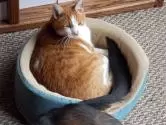Our Arts and Crafts Pets

Its been one of those weeks with nothing newsworthy to report, so I have recycled a column I wrote several Decembers ago:
Leigh Ann and I live in a typical, 1970s, split-level ranch house. What makes it not so typical is that it sits on top of a wooded knoll with spectacular views of Mt. Pisgah and the Blue Ridge Mountains, twenty miles to the west. With these views, I wouldn’t have cared if it had been a wooden shack with a privy out back.
Given my love for Arts & Crafts furniture, it should come as no surprise that each December we have a decision to make: what has to leave to make room for the Christmas tree?
Often the decision is made according to which piece needs to go into my workshop for a tune-up. Our collection is not really a collection. They are the pieces we live with on a daily basis. It’s a mixture of antiques, reproductions, a few pieces I have made, and a modern couch. And it accommodates not just us, but our two rescue dogs, Daisy and Jasper, along with an occasional visit by one of our outdoor cats.
This year the piece which needed to go into my workshop was one of my prized possessions: a leather-topped hexagon table made in the workshops of Gustav Stickley in 1904. This piece had literally been driven into my driveway several years ago by someone who knew I collected Stickley, and who also knew the significance of that large red decal stuck to the underside of the top. I gulped hard, but paid the asking price.

The oak base was in near-perfect condition with its original shellac finish. The top was chestnut and not so perfect: nothing remained of the original leather top. I spent several weeks doing my research, talking with dealers and collectors, tracking down a source of thick cowhide large enough to stretch across the five-foot wide top, determining how to attach it and, then, how to dye and finish it to look like an original.
The table eventually emerged from my workshop and proudly took its place in our living room. The large expanse of leather was softened by a reproduction Gustav Stickley table runner and a copper and mica lamp made by craftsman Michael Adams in the style of Dirk van Erp.
While I was pleased that day with the color I had dyed the new leather, it still looked new to me. What it lacked I did not have the nerve to provide: those unmistakable signs of age – water marks, scratches, dents and stains. While I waged an internal debate, my cat took action. A half-hearted attempt to leap onto the table left him hanging like an Alpine skier after a bad take-off. His front claws sunk into the soft material, then, as the weight of his lower body pulled him back toward the floor, he plowed eight thin furrows across my field of leather.
Everyone, including the cat, held their breath, waiting to see how I would react. The scratches were hideous and there would be no hiding them under the table runner, no sanding them out. I gulped hard and forced a smile.
Twenty years later, the leather top on my Gustav Stickley table had picked up more than a few additional signs of age, but what bothered me the most was how the sun had bleached out much of the color I had applied. So, the hexagon table went back to my workshop, where I removed the wax finish and carefully re-dyed the leather. The cat scratches remained, but now they looked as old as the base.
Once it dried, I applied a fresh coat of paste wax, then buffed it to a hard eggshell sheen. Then Leigh Ann and I carried the base and then the top back to the house, and set it back in place.
A few hours later, as I was coming in to clean up, Percy, our yellow cat, met me at the door with what seemed a suspicious look on his face. I let him out and headed toward the living room. Just as I suspected, there they were – a fresh set of claw scratches along the edge of my newly-restored leather top.
This time I didn’t even gulp. I just smiled.

Until next Monday,
Think Asheville in February!!!!
Bruce
